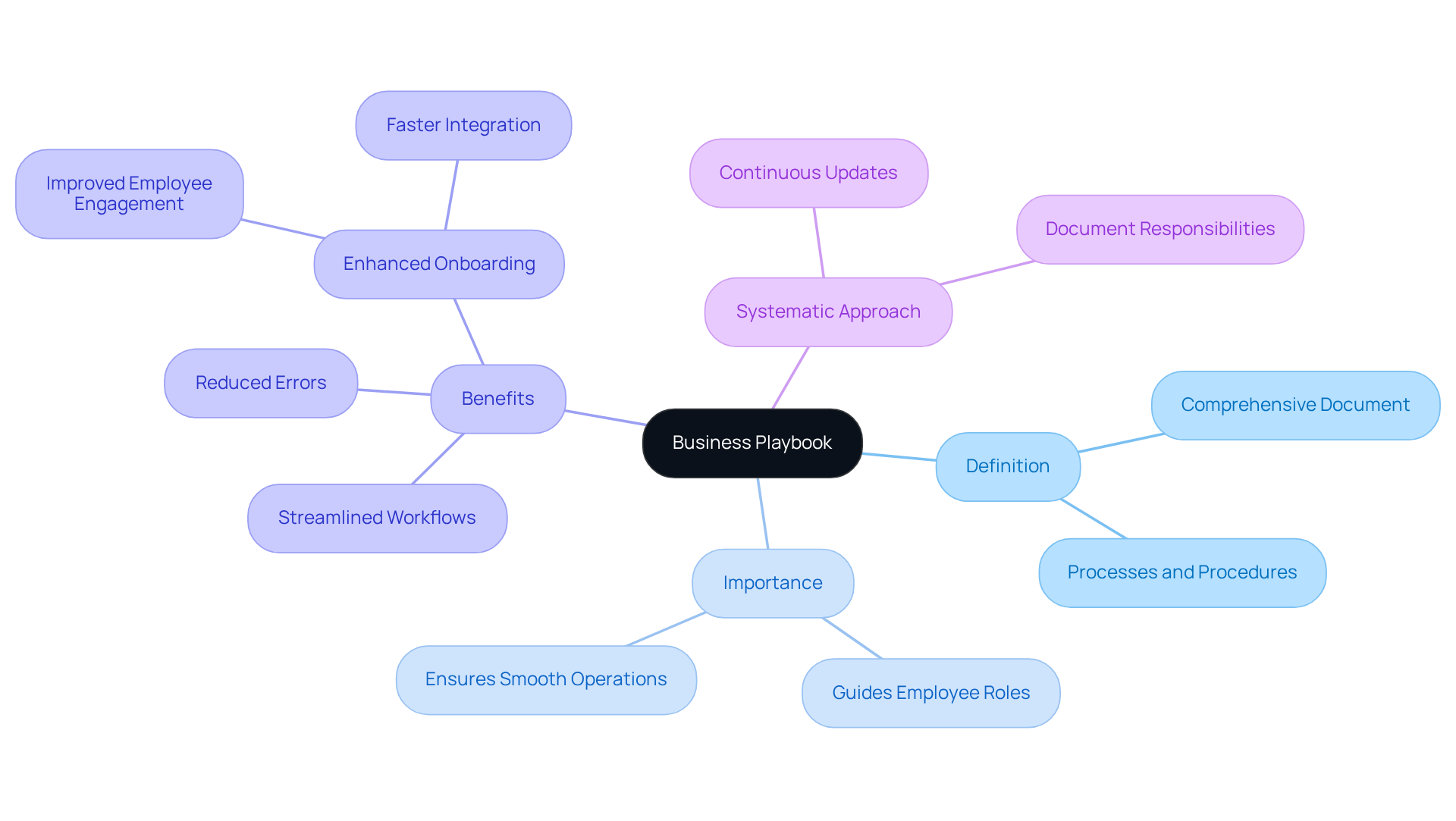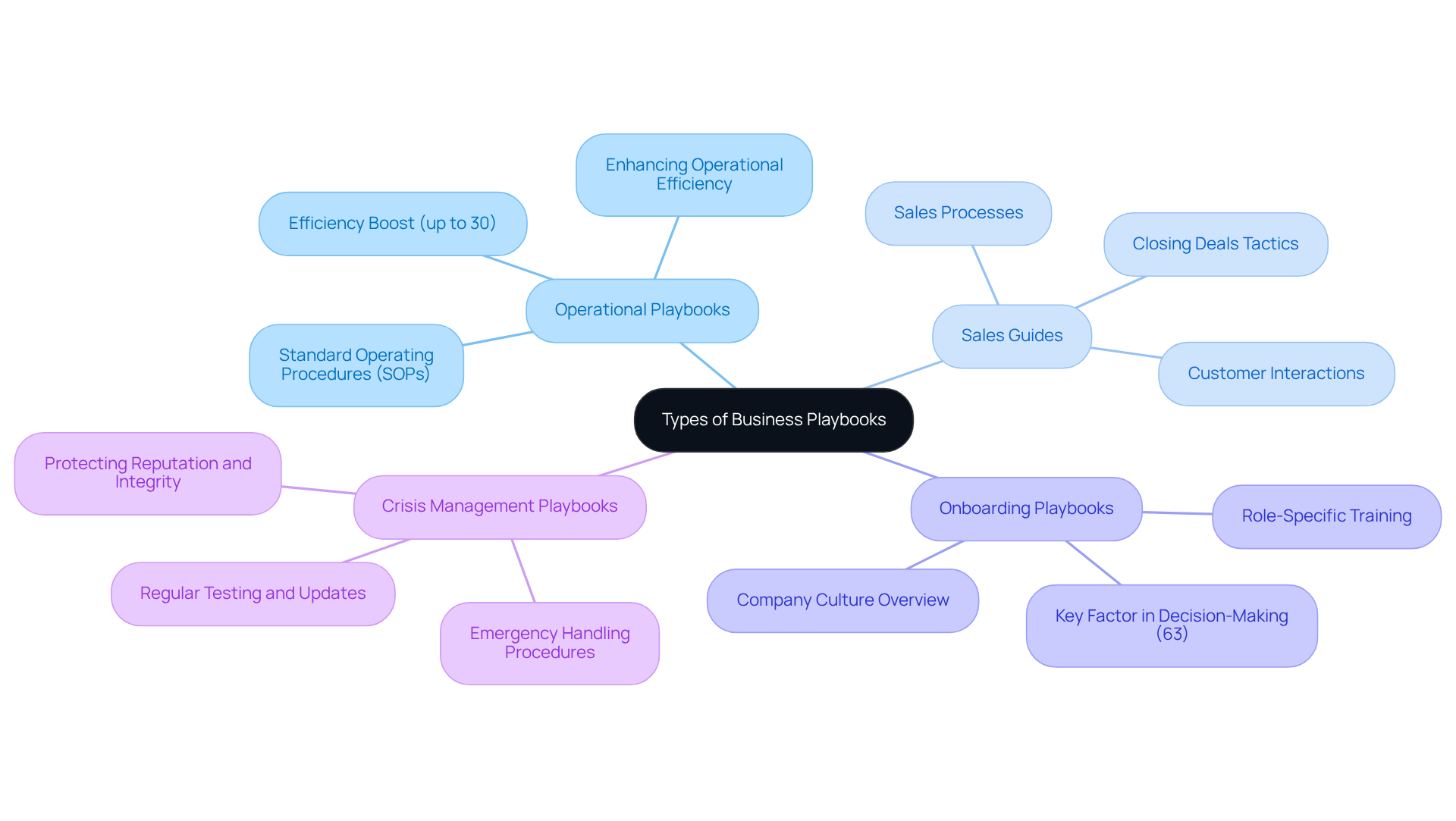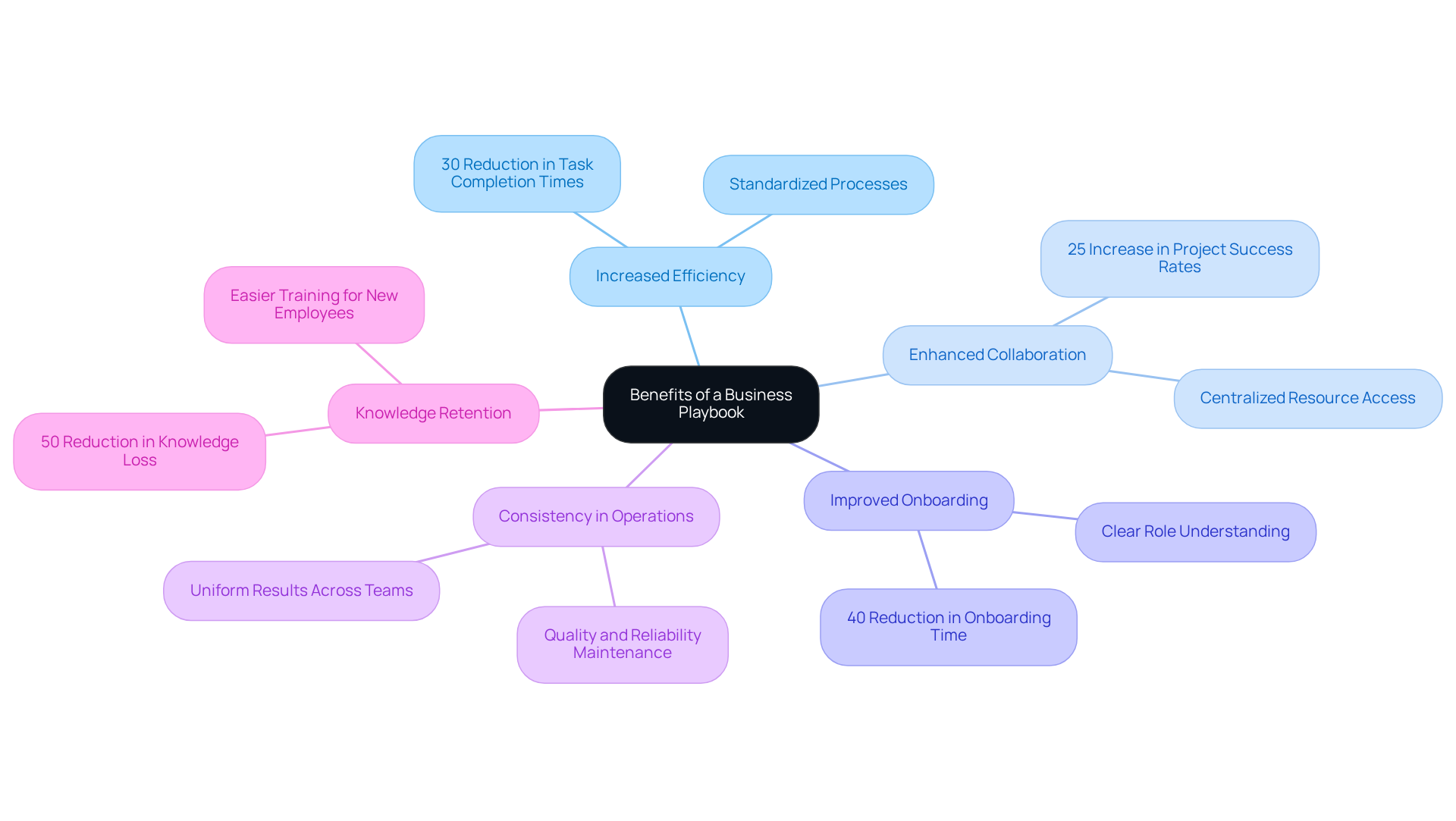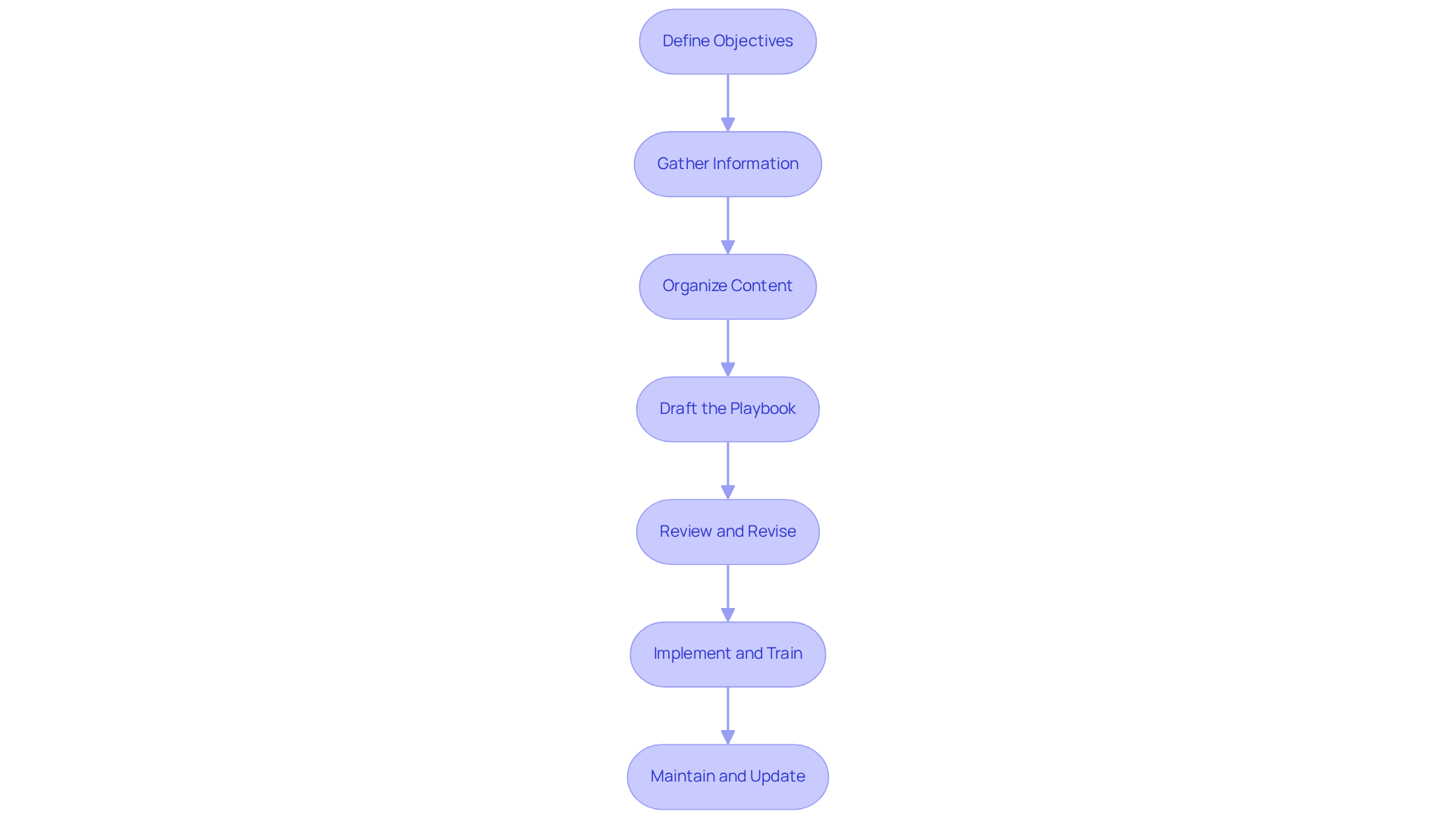
Remote Team Documentation Strategies
|
October 17, 2025
|
Understanding Playbook Meaning in Business: A Complete Guide
Overview
You might be wondering what a business playbook really is. Well, it’s a comprehensive document that outlines processes, procedures, and best practices designed to guide employees. By doing this, it enhances efficiency and collaboration within an organization. Now, let’s dive into how playbooks can streamline workflows, improve onboarding, and even reduce knowledge loss. Ultimately, they lead to a more organized and effective operational framework, making life a lot easier for everyone involved.
Key Highlights:
- A business playbook is a comprehensive document that outlines processes, procedures, and best practises to guide employees in their roles.
- It helps streamline workflows, reduce errors, and ease the onboarding process for new team members.
- Documentation should be a systematic, ongoing task with clear ownership to maintain relevance and effectiveness.
- Types of business playbooks include Operational Playbooks, Sales Guides, Onboarding Playbooks, and Crisis Management Playbooks, each tailored to specific organisational needs.
- Operational Playbooks can boost efficiency by up to 30% by standardising day-to-day processes.
- Sales Guides equip sales teams with necessary processes and tactics to close deals effectively.
- Onboarding Playbooks help new hires acclimate quickly, potentially reducing onboarding time by 40%.
- Crisis Management Playbooks prepare teams for emergencies, ensuring operational integrity and protecting reputation.
- Benefits of a business playbook include increased efficiency, enhanced collaboration, improved onboarding, consistency in operations, and knowledge retention.
- Organisations using playbooks can see a 50% reduction in knowledge loss during staff transitions.
- Creating a business playbook involves defining objectives, gathering information, organising content, drafting, reviewing, implementing, and maintaining the document.
Introduction
You might be wondering how understanding the intricacies of a business playbook can really change the game for organizations. Well, it’s all about providing a structured framework that boosts efficiency and collaboration. Think of a business playbook as your go-to guide—it not only clarifies roles and responsibilities but also streamlines processes, paving the way for improved productivity.
But here’s the kicker: with so many types of playbooks out there, how can businesses customize these resources to fit their unique needs while dodging common pitfalls? Let’s dive into that!
Define Business Playbook: Core Concepts and Importance
You might be wondering what a business manual really is. Well, it's a comprehensive document that lays out all the processes, procedures, and best practices within an organization. Think of it as a guide for employees to grasp their roles and responsibilities, ensuring everything runs smoothly. The beauty of a business playbook, which reflects the playbook meaning in business, is that it helps streamline workflows, cut down on errors, and makes onboarding new team members a breeze. With a centralized resource at their fingertips, teams can quickly find the info they need, boosting productivity and fostering collaboration across departments.
At SowFlow, we believe that documentation shouldn't just be a one-time task. Instead, it should be a systematic approach that becomes part of the organization's fabric. This means assigning clear document responsibilities and ownership, so the business framework stays fresh and relevant. By adopting this systematic mindset, teams can focus on high-value work without the hassle of sifting through outdated info. In short, a business guide embodies the playbook meaning in business, acting like a roadmap for reaching your goals, providing clarity and direction for everyone while adapting to the ever-changing needs of the organization.

Explore Types of Business Playbooks: Tailoring to Organizational Needs
You might be wondering about the different types of business playbooks and the playbook meaning in business, and how they can really make a difference. Well, let’s break it down!
- Operational Playbooks: These are all about the nitty-gritty of day-to-day operations. They lay out standard operating procedures (SOPs) for various tasks, helping to keep things running smoothly. Did you know that organizations using operational guidelines can boost their efficiency by up to 30%? As Irina Vatafu, Head of Customer Success at Custify, puts it, "Playbooks increase our operational efficiency, help us deliver our customers’ outcomes while increasing their MRR and demonstrating the value of customer success within our respective organizations."
- Sales Guides: These are created specifically for sales teams. They detail the sales processes, customer interactions, and the tactics needed to close deals. Think of them as a toolkit that ensures sales reps have everything they need right at their fingertips.
- Onboarding Playbooks: Tailored for new hires, these playbooks share the scoop on company culture, policies, and specific roles. A solid onboarding guide can really speed up the time it takes for newcomers to hit the ground running. In fact, 63% of customers see onboarding as a key factor in their decision-making!
- Crisis Management Playbooks: These are crucial for when the unexpected happens. They outline how to handle emergencies, ensuring teams know exactly what to do. Regular testing and updates are a must here, as they can really amp up a company's readiness for crises, ultimately protecting its reputation and operational integrity.
By understanding the playbook meaning in business, organizations can create guides that cater to their unique needs, resulting in improved efficiency and effectiveness across the board. Plus, avoiding common pitfalls like complexity and poor design is key to making sure these guides are user-friendly and effective. Collaborating with other departments during the development process can also boost the relevance and usability of these guides. So, are you ready to dive into creating some effective documentation?

Identify Benefits of a Business Playbook: Enhancing Efficiency and Collaboration
You might be wondering why the playbook meaning in business is considered such a big deal when implementing it. Well, it turns out that it comes with a ton of advantages that can really boost your organization’s performance!
First off, let’s talk about increased efficiency. When you standardize processes, your teams can zip through tasks faster and with fewer mistakes. Research shows that organizations using playbooks can cut task completion times by up to 30%! That’s a game-changer for streamlining operations and avoiding delays. Plus, with SowFlow's instant SOP creation feature, you can document processes right in your browser without having to take separate screenshots. Talk about saving time!
Now, onto enhanced collaboration. A centralized resource can really up your communication game, ensuring everyone has access to the same information. This collaborative vibe can lead to a 25% increase in project success rates, as teams work together more effectively towards common goals. And get this—staff members often enjoy an average of four or more benefits from guides, showcasing their versatility.
What about improved onboarding? New hires will appreciate a clear understanding of their roles and the company’s processes, helping them get up to speed quickly. In fact, playbooks can slash onboarding time by as much as 40%, allowing newcomers to start contributing in no time.
Then there’s consistency in operations. By making sure everyone follows the same procedures, you promote uniform results across the board. This consistency is key to maintaining quality and reliability in your service delivery.
And let’s not forget about knowledge retention. Documenting processes helps preserve institutional knowledge, making it easier to train future employees and keep things running smoothly during staff turnover. Organizations that use playbooks have reported a 50% reduction in knowledge loss during transitions, which is crucial for safeguarding important information.
When you put all these advantages together, you create a more organized and scalable organization. This allows your teams to focus on strategic initiatives instead of getting bogged down in operational chaos. Our clients rave about how SowFlow's instant SOP creation features improve documentation efficiency and user experience, letting teams concentrate on what really matters.
But remember, it’s essential to regularly check and update your strategies every six months to keep them relevant and effective. As Joe Tawfik points out, companies need to act now to revise their strategies to thrive in an AI-driven world. Did you know that the playbook meaning in business comes from American football, where strategies are documented for players? It really highlights its importance in business strategy! Plus, adopting a new strategy often requires cultural shifts and a commitment to ethical AI use, helping organizations adapt to modern challenges.

Create a Business Playbook: Step-by-Step Guide to Implementation
Creating a playbook meaning in business is a journey that involves several essential steps, and trust me, these can really boost your organizational efficiency and clarity!
You might be wondering where to start. First up, Define Objectives. Pinpoint the goals of your guide. Think about what processes need documentation and who will be using it. With SowFlow's instant documentation solution, you can define these objectives clearly, ensuring that your playbook aligns perfectly with your group's needs.
Next, let’s Gather Information. Collaborate with your colleagues to compile existing documentation, insights, and best practices that relate to the processes you want to include. SowFlow empowers you to summon the wisdom of your documentation with just a single command, making it super easy to gather comprehensive perspectives from various team members.
Now, it’s time to Organize Content. Structure your playbook logically by grouping related processes and procedures together. SowFlow's user-friendly interface makes organization a breeze, allowing for quick access to information and enhancing workflow sharing.
Once that’s done, let’s Draft the Playbook. Write clear and concise instructions for each process. Don’t forget to incorporate visuals or flowcharts to make understanding and retention a whole lot easier! With SowFlow, you can whip up user guides effortlessly, ensuring your instructions are both informative and engaging.
After drafting, it’s crucial to Review and Revise. Share the draft with stakeholders for feedback. This step is vital for ensuring accuracy and clarity, as diverse perspectives can highlight areas for improvement. SowFlow makes updating and revising your documentation a piece of cake, keeping it relevant in our ever-changing business environment.
Next up, Implement and Train. Distribute the guide to your team and conduct training sessions to familiarize everyone with its content and usage. Effective training is key to maximizing the guide's impact, and SowFlow's streamlined documentation can serve as a valuable training resource.
Finally, don’t forget to Maintain and Update. Regularly review the guidelines to keep them fresh and relevant. Integrate suggestions and adjust to changes in procedures as needed, ensuring that the guide evolves with your organization. Thanks to SowFlow's instant updates, you can keep your documentation effortlessly, making sure your guide remains an essential resource for all team members.
By following these steps and leveraging SowFlow's features, you can create a thorough business guide that promotes consistency and scalability in operations. Did you know that businesses that grasp the playbook meaning in business often see improved performance and reduced turnover? It really underscores the value of this strategic tool. As Ioana Wilkinson aptly put it, "Running a business without a plan is like driving without a map—you might reach your destination, but not efficiently.

Conclusion
You might be wondering what exactly a business playbook is and why it’s so important. Well, think of it as a vital resource that captures all the processes, procedures, and best practices that an organization needs to succeed. It acts like a comprehensive guide for employees, helping to clarify roles and responsibilities. Plus, it streamlines workflows, reduces errors, and makes onboarding a breeze. The playbook's meaning in business really underscores the need for a structured approach to documentation, ensuring that teams stay aligned and focused on their goals while they adapt to the ever-changing work environment.
Now, let’s dive into the different types of business playbooks! We’ve explored operational, sales, onboarding, and crisis management playbooks, each serving a unique purpose. These playbooks contribute to increased efficiency, improved collaboration, and better onboarding experiences. The benefits of having a business playbook are pretty significant, ranging from saving time and ensuring consistency in operations to enhancing knowledge retention and helping organizations scale. Just remember, regular updates and a commitment to keeping things relevant are key to maximizing the effectiveness of these guides.
Ultimately, we can’t overstate the significance of a business playbook. Organizations that embrace this strategic tool not only boost their operational efficiency but also cultivate a culture of collaboration and continuous improvement. As businesses tackle the complexities of modern challenges, investing in a well-structured playbook becomes essential for achieving long-term success. By taking the necessary steps to create and maintain a business playbook, organizations can ensure they’re ready to meet their goals and thrive in an ever-evolving landscape.
Frequently Asked Questions
What is a business playbook?
A business playbook is a comprehensive document that outlines all the processes, procedures, and best practices within an organization, serving as a guide for employees to understand their roles and responsibilities.
What are the benefits of having a business playbook?
A business playbook helps streamline workflows, reduce errors, and simplify the onboarding process for new team members, ultimately boosting productivity and fostering collaboration across departments.
How should documentation be approached in an organization?
Documentation should be a systematic approach that becomes part of the organization's fabric, with clear responsibilities and ownership assigned to keep the business framework fresh and relevant.
Why is it important for a business playbook to stay updated?
Keeping the business playbook updated allows teams to focus on high-value work without the hassle of dealing with outdated information, ensuring that the playbook adapts to the ever-changing needs of the organization.
How does a business playbook act as a roadmap for an organization?
A business playbook provides clarity and direction for everyone in the organization, helping to align efforts toward reaching goals while adapting to changes as needed.
👍
What others are liking
5 Steps to outline your ideal documentation structure
5 MINS READ
Where to start the your journey of mapping out your ideal documentation structure, aligning it with the very heartbeat of your organization?
Defining a winning level of detail in your process
3 MINS READ
What is too much detail, and what is too little? This article described in that winning level detail about what detail is enough.





